

Business_Model_Innovation.pdf (application/pdf Object) Business Model Innovation is the Gift that Keeps on Giving - Karan Girotra and Serguei Netessine. By Karan Girotra and Serguei Netessine | 11:00 AM December 5, 2012 With the Winter holiday shopping season, fashion apparel retailer Zara has been the focus of media attention — the New York Times recently profiled the innovative fast fashion business model pioneered by Zara, while Elizabeth Cline’s book on the costs of fast fashion has climbed up the sales charts.

Despite this very recent popularity, the novel business model of Zara has gone virtually unnoticed for over 30 years, allowing Zara’s parent company, Inditex, to grow from zero to almost $20B in revenues. Why wasn’t it copied immediately? How can it be so sustainable and continue growing? Why the Business Case is Killing Innovation. Most business cases outline a problem, some potential solutions, and an investment strategy in the hope of gaining approval.
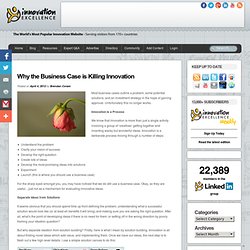
Unfortunately this no longer works. Innovation is a Process We know that innovation is more than just a single activity involving a group of ‘creatives’ getting together and inventing wacky but wonderful ideas. 'Business Model Innovation is the Fastest Path to Greatness' What is a Business Model? “How do you expect to make money?”
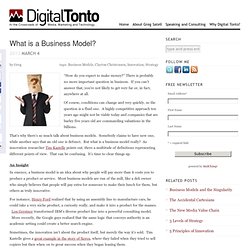
There is probably no more important question in business. If you can’t answer that, you’re not likely to get very far or, in fact, anywhere at all. Of course, conditions can change and very quickly, so the question is a fluid one. A highly competitive approach ten years ago might not be viable today and companies that are barley five years old are commanding valuations in the billions. Multiple Use of the Business Model Canvas. Recently I was having a ‘conversation’ with Alexander Osterwalder concerning the limited adoption of the Business Model Canvas within large organizations.
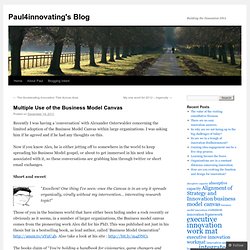
I was asking him if he agreed and if he had any thoughts on this. Now if you know Alex, he is either jetting off to somewhere in the world to keep spreading his Business Model gospel, or about to get immersed in his next idea associated with it, so these conversations are grabbing him through twitter or short email exchanges. Short and sweet ”Excellent! One thing I’ve seen: once the Canvas is in an org it spreads organically, virally without my intervention… interesting research topic!”
Those of you in the business world that have either been hiding under a rock recently or obviously as it seems, in a number of larger organizations, the Business model canvas comes from the pioneering work Alex did for his PhD. Without doubt this book weaves design throughout, to give you a visual feast through its canvas approach. Building Dynamic Business Models. How can established organizations innovate their business model?
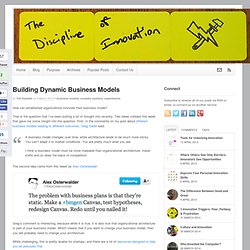
That is the question that I’ve been putting a lot of thought into recently. Two ideas collided this week that gave me some insight into the question. First, in the comments on my post about different business models leading to different outcomes, Greg Satell said: A business model changes over time, while architecture tends to be much more sticky. You can’t adapt it to market conditions. The second idea came from this tweet by Alex Osterwalder: Better Business Models Lead to Better Businesses. I read in a blog post over the weekend about someone who had switched from an iPhone to a Samsung Galaxy smartphone.
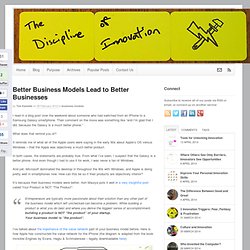
Their comment on the move was something like “and I’m glad that I did, because the Galaxy is a much better phone.” What does that remind you of? It reminds me of what all of the Apple users were saying in the early 90s about Apple’s OS versus Windows – that the Apple was objectively a much better product. In both cases, the statements are probably true. From what I’ve seen, I suspect that the Galaxy is a better phone. And yet, Microsoft dominated the desktop in throughout the 90s with Windows, and Apple is doing pretty well in smartphones now. Business Models. Are these Valid Research Gaps in Current Business Model Literature: What you think?
Creating Value Through Business Model Innovation. References (28) 1.
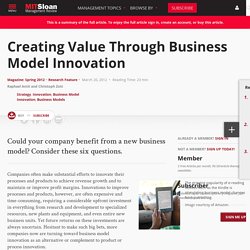
“Business 2010: Embracing the Challenge of Change,” white paper, Economist Intelligence Unit, New York, February 2005, p. 9. 2. G. Pohle and M. 3. 4. 5. 6. 7. 8. 9. Design Your Company, Not Your Product. When you think of creating a company, all the focus is usually on what you want to make: how the app will work on someone's phone or how attractive your product will look like on store shelves.
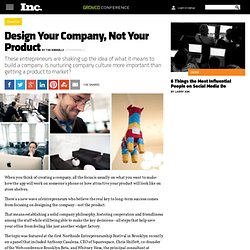
There's a new wave of entrepreneurs who believe the real key to long-term success comes from focusing on designing the company--not the product. That means establishing a solid company philosophy, fostering cooperation and friendliness among the staff while still being able to make the key decisions--all steps that help save your office from feeling like just another widget factory. The topic was featured at the first Northside Entrepreneurship Festival in Brooklyn recently on a panel that included Anthony Casalena, CEO of Squarespace, Chris Shiflett, co-founder of the Web conference Brooklyn Beta, and Whitney Hess, the principal consultant at user-experience consultancy Vicarious Partners. 1. Have a crystal-clear mission statement. Hess said to remember that all businesses exist to solve a problem.